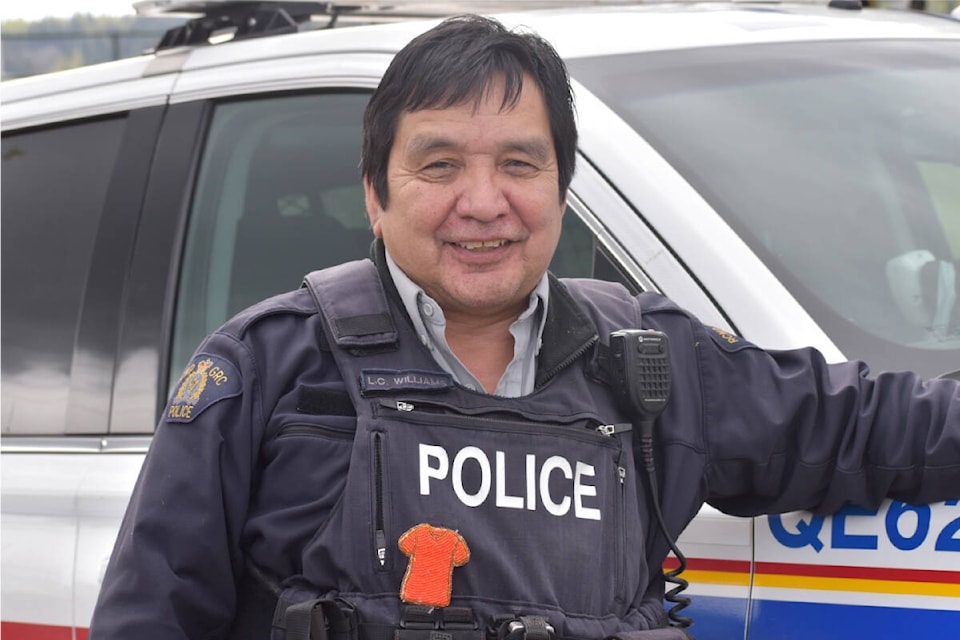On his dark-coloured RCMP uniform Cst. Chester Williams wears a beaded orange shirt made by his wife.
“It’s a constant reminder we’ll never ever forget our children,” Williams said.
Williams joined the RCMP in 1999 and, throughout his service, has worked with Indigenous communities across B.C. near Smithers, 100 Mile House, Prince George and Merritt where he was stationed.
He is currently based in Quesnel, where community interaction is at the heart of his job.
“My position is more proactive than reactive,” Williams said. “I go in and try to bring programs versus going in and arresting all the time.”
Williams can regularly be seen participating in community events such as Red Dress Day and, most recently, the first annual 215 Memorial Walk held at Quesnel Junior School. However, if he gets a police call, he is prepared to promptly leave and drive out to Lhtako Dené, Lhoosk’uz Dené, Nazko and ?Esdilagh First Nations.
“I get the best of both worlds,” Williams said, noting at the end of the day he is still a police officer. “I do what I love to do.”
Williams said as an Indigenous child he used to run from the police.
Williams didn’t know why but it wasn’t until he got older that he began to understand it was because of residential schools.
“I joined this organization because I wanted to change the stigma that police were bad because we as a police agency had to go and apprehend the kids,” Williams said.
“I want to change that, so our people have a better understanding of who we are and where we’re going.”
Read More: Community marches in Nazko to honour, remember MMIWG
Williams recalled taking an RCMP course in Chilliwack in 2005 called Aboriginal Perceptions.
The five-day course covered a wide range of topics starting before European contact, during European contact and where we are today.
“On the third day of the course, I went holy smokes that’s me,” Williams said, adding he is now an instructor on Aboriginal Perceptions Training. “The light came on, and now I understood why I was the way I was.”
After European contact, Williams noted the Indian Act made it mandatory for every Indigenous child to attend a residential school.
Many survivors were left severely traumatized and, to cope, turned to alcohol or drugs to mask the hurt that trickled down to their children and their children’s children.
Williams, a Sixties Scoop survivor, attended the Miller Bay Indian Hospital for three years and went to Indian Day School in Kitwanga.
“All the things that happened in residential school happened in the Indian Day School but a little bit more to the extent where at Indian Day School we were treated like guinea pigs,” he said.
Each month different dentists would visit and perform tooth extractions. The only reason Williams said he still has his teeth is because his mom went to the school and told them not to touch her son’s teeth. He also remembers the students lining up in the basement where the air glittered when the sun shone through the windows with asbestos when a portable x-ray machine arrived.
Read More: Help heal Indigenous residential school trauma, public safety minister tells RCMP
Today Williams shares his Aboriginal Perceptions with others and usually introduces himself first with his traditional name, followed by his Christian name.
He said he was at GR Baker Hospital in Quesnel several weeks ago and that many staff did not know what had happened.
“It is part of history, but it seems like this little dark secret that everybody has,” Williams said. “When they’re teaching about residential school in the high schools they’re teaching the watered-down version of what happened, so my Aboriginal perception, I tell the stories of what the survivors had told me, my parents and everyone like that.”
For years Williams said their stories were ignored.
He said he disagrees with how the Canadian Government is responding to the ongoing impacts by “throwing money and saying this is what you need.”
“We need more of our own traditions; we need our elders coming in and talking,” Williams maintains.
“Prior to European contact, our women were up over here,” he said, pointing towards the ceiling. “After European contact, our women were down over here, and they made our men chiefs, that’s not the way it was … we have to get back to before European contact which we are working our way towards now with these ceremonies, and we’re slowly getting there.”
Williams encourages parents to support their children with whatever their future aspirations may be.
When he speaks with children, he tells them they are our future and to pursue their dreams.
Do you have something to add to this story, or something else we should report on? Email: rebecca.dyok@quesnelobserver.com
Like us on Facebook and follow us on Twitter.
